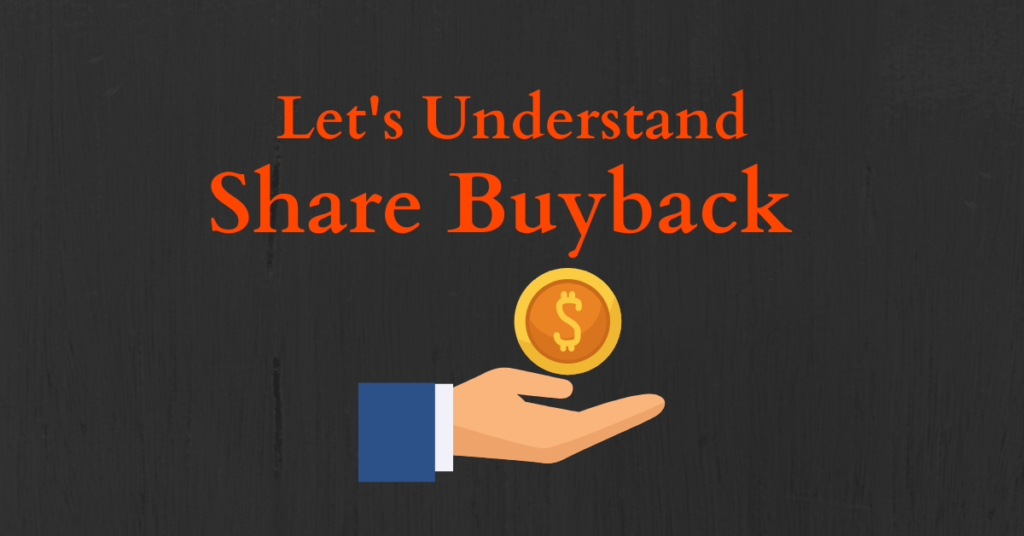In business, there are different stages where we can see the manager’s ability i.e. from starting to making a mature business.
Do you know what is the main job of managers? Yes, you get it right. It’s to use the available resources to get better returns over time.
And even after making a profitable and sustainable business, the responsibility of managers is not going to end.
Asset allocation is most crucial especially when it comes to excess cash.
Contents
The share buyback is an accounting re-engineering by which companies opt to buyback their own shares from the existing shareholders.
In a share buyback program, the ownership of shareholders increases in the companies by just reducing the no. of shares.
Before jumping deep into the buyback, let’s first understand the below concept.
What a company can do with the Cash it earned?
There are five things a company can do with the cash they earn.
- Re-invest in the existing business.
- Acquire other businesses or assets.
- Pay down debt.
- Pay dividends.
- Buy in Shares.
Let’s discuss one-by-one.
-
Re-invest in the existing business
Most of the companies invest their earnings in their existing business. It’s a very positive sign when the company invests in their business because it shows that companies’ promoters believe in their business.
Re-investing in business helps a company in many ways. It helps a company to add a new product line, set-up a new factory, acquire more customers, and gain market share, etc.
The approach is very common in startups, small-size, and mid-size companies.
-
Acquire other businesses or Assets
Acquiring a small business also helps a company to grow revenue by just buying a business. It helps companies in many ways, it helps companies to add new products to their portfolio, gain market share by acquiring competitors, and hence to increase further market share.
Companies like HUL and Nestle often do such practices, and you can see their past record and product line.
-
Pay Down Debts
Paying down debts also helps companies to boost their earnings and to make a healthy and strong balance sheet which helps companies to do business without any financial pressure especially in the time of economic slowdown.
Reducing debts means reducing interest costs which help further to boost companies’ earnings.
-
Pay Dividends
A dividend is nothing but the profit share which directly goes to the shareholder’s pocket. Some companies pay a greater portion of their profit as dividends while some pay very little or none, it depends upon the capital required to fund the current business.
Most startups and growing companies don’t pay dividends instead they invest in their existing business to capture market share or acquire more customers which is a very good sign.
If a company pays a considerable part of its profit as dividends then most of the time it means the company is operating in an almost saturated market and don’t have enough market for further growth.
Dividends are neither good nor bad. It all depends upon the investors’ objective. Most investors avoid dividends because of dividends tax.
Pay in dividends is a good option to maintain high ROE because idly excess cash wouldn’t give enough returns, so companies opt to pay dividends.
Castrol India Ltd is the best example of this scenario which is currently paying 90% of its profit as dividends, i.e, has a dividend payout ratio of 90%.
Learn Dividend Payout Ratios and 21 other Financial Ratios Every Investor should know
This is the last decision management often takes, usually when the company still has a huge pile of cash and no option is left for further investment.
Mr. Warren Buffett often recommends buying back shares especially when the share price of the company trade below its intrinsic value.
Also, management should avoid buyback when the shares are traded far above the intrinsic value.
Now, we have understood why companies buyback shares. But it is good or bad!
- Best-way to allocate excess cash
- It shows a positive sign that management has faith in the long-term prospects of their business.
- By just reducing the no. of shares, earning per share(EPS) increases. Make sure that the Net Earnings will remain the same.
- Those investors who will remain invested will be benefitted the most when the share will be buyback at its intrinsic value.
- Buyback in shares means a reduction in no. of shares, hence the low supply of shares will increase demand of shares so the price.
The buyback plan also comes with some negative factors, so what are these!
- Share buyback plan shows that the company is doing business in a saturated market, i.e. doesn’t have enough market for further growth.
- Buying back far above the intrinsic value of share price will cost the company extra cash, which ultimately will result in a poor asset allocation.
Closing Thoughts
Even though the Share Buyback plan comes with great excitement in the investor’s community, it’s not always profitable. It’s all depends upon multiple factors discussed above.
Legendary investor Mr. Warren Buffet promote share buyback plan over dividends to avoid dividend tax and maintain existing shareholders for the long term benefits.


